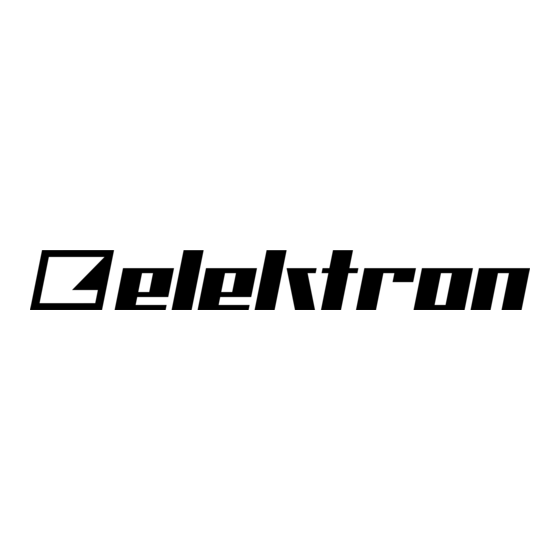
Table of Contents
Advertisement
Advertisement
Table of Contents

Summary of Contents for Elektron Digitone Keys
- Page 1 Digitone Keys Quick Guide...
- Page 3 Digitone Keys THANK YOU Thank you for purchasing Digitone Keys. The Digitone Keys represents our vision of how FM synthesis can be revitalized and modernized. Here’s how: combine FM sound genera- tion with a classic subtractive synthesis signal flow. You go from jagged chaos to mellow soundscapes in less than a second.
- Page 4 FCC compliance statement This device complies with part 15 of the FCC rules. Operation is subject to the follow- ing two conditions: (1) This device may not cause harmful interference, and (2) this device must accept any interference received, including interference that may cause undesired operation.
- Page 5 In no event shall Elektron be liable for any special, indirect, or consequential damages or any damages whatsoever resulting from loss of use, data, or profits, whether in an action of contract, negligence, or other action, arising out of or in connection with the use or performance of this information.
- Page 6 IMPORTANT SAFETY INSTRUCTIONS 1. Do not use the unit near water. 2. Never use aggressive cleaners on the casing or on the screen. Remove dust, dirt and fingerprints with a soft, dry and non-abrasive cloth. More persistent dirt can be removed with a slightly damp cloth using only water.
- Page 7 • In the EU, only use CE approved power cords. RESTART • For a complete restart of the Digitone Keys, wait for at least 30 seconds after turning it off before turning it on again.
-
Page 8: Table Of Contents
1.2 REAR PANEL CONNECTIONS ..........13 2. GETTING STARTED WITH DIGITONE KEYS ..............14 2.1 SETTING UP AND STARTING . -
Page 9: Panel Layout And Connections
1. PANEL LAYOUT AND CONNECTIONS 1.1 FRONT PANEL CONTROLS 1. MASTER VOLUME sets the volume for the main outputs and the headphone output. 2. PITCH WHEEL applies pitch bend and other assignable modulations. 3. MOD WHEEL applies assignable modulations. 4. [MIDI] activates the MIDI editing mode where you can edit the MIDI tracks. A lit [MIDI] key indicates the MIDI editing mode is active. - Page 10 5. [FUNC] key. Press and hold [FUNC], and then press another key to access the sec- ondary function of that key. The turquoise text on the Digitone Keys front panel shows the keys´ secondary functions. 6. [SOUND BROWSER] opens the Sound Browser where you can preview and load Sounds.
- Page 11 DATA ENTRY knobs. They also select banks, and patterns, in combination with the [PTN], and [BANK] keys. The [TRIG] keys also function as a keyboard to play the Digitone Keys or to input notes chromatically into the sequencer. 22. [STOP] stops the sequencer playback. The secondary function is a paste operation.
- Page 12 30. [HOLD] toggles the Hold function on/off. The secondary function toggles the Porta- mento function on/off. The <PORTAMENTO> LED indicates the portamento's status. 31. [ARPEGGIATOR] toggles the arpeggiator on and off. The secondary function opens the ARPEGGIATOR menu. 32. [MULTI MAP] toggles the MULTI MAP mode on/off.
-
Page 13: Rear Panel Connections
1.2 REAR PANEL CONNECTIONS 1. POWER Switch for turning the unit on and off. 2. DC In Input for power supply. Use the included PSU-3b power adapter, connected to a power outlet. 3. USB For connecting the unit to a computer. For MIDI-control, data transfer or Overbridge use. -
Page 14: Getting Started With Digitone Keys
USB connector of the Digitone Keys. 4. If you want to use MIDI to control the Digitone Keys, connect the MIDI OUT port of the device you wish to use as a controller to the MIDI IN port of the Digitone Keys. If you want to use Digitone Keys to control other devices using MIDI, connect the MIDI OUT port of the Digitone Keys to the MIDI IN port of the of the device you want to control. -
Page 15: Playing The Factory Preset Patterns
2.3 PLAYING THE FACTORY PRESET PATTERNS You can find a number of preset patterns and Sounds in the Digitone Keys. Follow the instructions below to start exploring your new instrument. 1. Press [BANK] and then press [TRIG 9] key to select bank A. The screen reads “BANK A : SELECT PTN”. -
Page 16: Parameter Editing
1. Bank and pattern. 2. Pattern name. 3. Pattern/Track transpose. 4. Tempo. 5. Eight track parameters. They show what parameters the DATA ENTRY knobs control, and the current parameter values. 6. FM algorithm (Displayed on the SYN1 and SYN2 pages). 7. -
Page 17: Func] Key Press Combinations
4.1 TRIGS AND TRIG TYPES A trig is a sequencer event that you can place where you want the sequencer to perform an action on the Digitone Keys. There are two types of trigs available in the sequencer: Note trigs and Lock trigs. -
Page 18: Live Recording Mode
3. Select another track, and add note trigs and lock trigs. 4. Press [PLAY] to listen to the sequence. 4.4 LIVE RECORDING MODE LIVE RECORDING mode is the second method of adding trigs to the tracks. In this record- ing mode, the [KEYBOARD] and the [TRIG] keys are played in real time to input trigs to the tracks.










Need help?
Do you have a question about the Digitone Keys and is the answer not in the manual?
Questions and answers